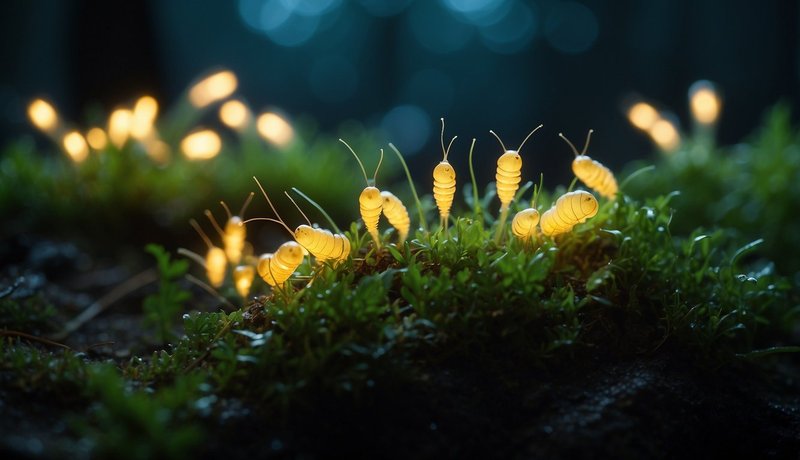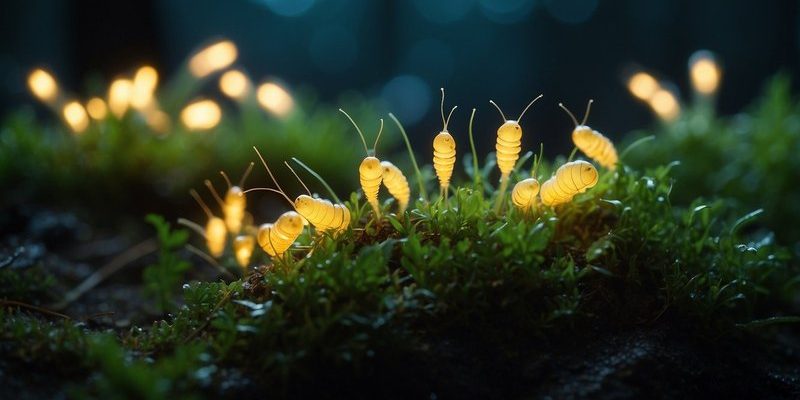
Glow worms aren’t just pretty lights; they’re an integral part of their habitats. They’re found in various places around the world, but their impact on forests is particularly noteworthy. By breaking down waste and providing food for other creatures, glow worms help maintain the balance of their ecosystems. So, what exactly do these glowing critters do, and why should we care? Let me shed some light on their role in our forests.
What Are Glow Worms?
Glow worms are the larval stage of various beetle species, with the best-known ones belonging to the *Lampyridae* family. Contrary to what you might think, the term “glow worm” can refer to different species across the globe. For instance, in New Zealand, the *Aglowis robustus* is famous for its stunning displays of light.
Their glow comes from a chemical reaction that occurs in specialized cells. This luminescence serves a purpose: it attracts prey, like flying insects, into their sticky silk threads. You might say glow worms are nature’s little fishermen, using their light to lure their next meal.
In addition to their fascinating biology, glow worms have a short life cycle, spending most of their time in a larval stage. This brief existence adds to their charm and makes their role in the ecosystem even more captivating.
The Role of Glow Worms in Forest Ecosystems
Glow worms have several important functions in forest ecosystems. Here’s the thing: they aren’t just cute lights flitting around. They play a vital role in nutrient cycling, pest control, and even habitat creation.
Nutrient Cycling
Glow worms are decomposers, which means they help break down organic matter. As they feed on decaying leaves and other plant materials, they recycle nutrients back into the soil. This process enriches the forest floor, promoting the growth of new plants and maintaining biodiversity.
When glow worms die, their bodies decompose and further contribute to the nutrient pool. This nutrient cycling is essential for keeping the forest healthy and vibrant, allowing various species to thrive.
Pest Control
It’s a little-known fact that glow worms can help control insect populations. By attracting insects to their sticky webs, they reduce the number of pests that could otherwise damage plants. This natural pest control method is essential for maintaining the health of the forest.
By keeping insect populations in check, glow worms indirectly support the survival of other forest creatures, creating a balanced ecosystem where every organism plays a role.
Glow Worms and Biodiversity
The presence of glow worms can be a strong indicator of biodiversity in a forest. Healthy ecosystems tend to support a rich variety of species, and glow worms add to this richness. Their ability to thrive depends on a balanced ecosystem with clean water, adequate food sources, and a suitable habitat.
Having a population of glow worms can also signal a well-functioning environment. When these creatures are absent or in decline, it may indicate underlying issues, like pollution or habitat destruction. In this way, glow worms serve as a bellwether for the health of forest ecosystems.
Encouraging Biodiversity
By supporting glow worm populations, we promote biodiversity in our forests. This can be achieved through conservation efforts and habitat restoration. For instance, preserving areas with natural vegetation can provide the right conditions for these glowing larvae to thrive.
Additionally, protecting forests from invasive species can help maintain the delicate balance essential for glow worms and other native species to survive.
Glow Worms and Their Environmental Impact
The environmental impact of glow worms goes beyond just their role in nutrient cycling and pest control. Their unique lifestyle also influences the habitats they occupy. When glow worms build their silk webs, they create microhabitats that can support other smaller organisms.
Creating Microhabitats
These silk threads not only capture food; they also provide shelter for small insects and other creatures. Think of it as a tiny hotel in the forest, where various critters find refuge. This helps support a diverse range of life, enhancing the overall stability of the ecosystem.
Furthermore, glow worms are a reminder of the interconnectedness of life. Every creature, no matter how small, plays a part in the grand cycle of nature. Their presence adds complexity and interest to the ecosystem, reminding us how much we rely on each other and the environment.
Protecting Glow Worm Habitats
With glow worms being such a vital part of forest ecosystems, protecting their habitats is crucial. Human activities, like deforestation and pollution, pose significant threats to these luminescent larvae.
Conservation Efforts
Many organizations and communities are working to protect glow worm habitats. This includes restoring natural vegetation and reducing pollution in forest areas. Education and awareness campaigns can also help; when people understand the role of glow worms, they are more likely to take steps to protect them.
Additionally, creating designated conservation areas can safeguard these ecosystems from harmful human impact. By fostering environments where glow worms can thrive, we also create healthier forests for all.
The Magic of Glow Worms: Cultural Significance
Beyond their ecological importance, glow worms hold cultural significance in various regions. For example, in New Zealand, the glow worms in the Waitomo Caves are a major tourist attraction, drawing visitors from around the world. This fascination with their beauty goes hand-in-hand with a respect for their role in the ecosystem.
Inspiration for Art and Science
Their mesmerizing glow has inspired artists and scientists alike. Many stories, poems, and artworks center around the idea of light in darkness, using glow worms as a symbol of hope and resilience. From a scientific perspective, researchers continue to study their unique biology for insights into bioluminescence and its potential applications in medicine and technology.
In a way, glow worms bridge nature and culture, reminding us of the beauty that exists in the world and the importance of preserving it.
Glow worms are more than just beautiful lights in the dark; they are vital contributors to forest ecosystems. Through their roles in nutrient cycling, pest control, and supporting biodiversity, these little creatures are essential for maintaining the balance in our forests.
As we continue to explore and understand the world around us, let’s remember the importance of protecting these glowing wonders. By caring for glow worms, we’re caring for the larger web of life in which they play a crucial part. Their glow is not just a spectacle—it’s a reminder of the interconnectedness of our ecosystems and a call to action for their conservation. So next time you see a glow worm, take a moment to appreciate its role in the beautiful dance of nature.

